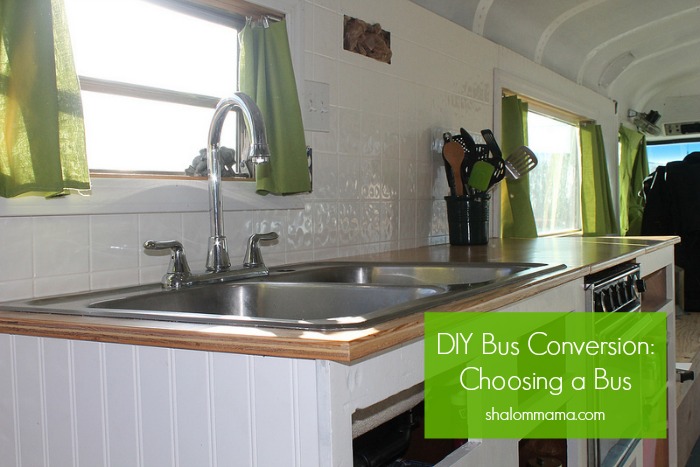A couple days ago I shared some steps you should take before you start searching for the bus you’ll use for your conversion. If you missed that post, you can find it here.

Today, I wanted to share some helpful tips for choosing a bus. Now that you know what you want your interior to look like, you can focus on the bus itself.
This are the criteria we looked at while we searched for our bus:
Space
Armed with your design, you’ll know how long of a bus you’ll need. When you’re searching for your bus, you’ll probably find yourself obsessed with bus length. Because in a house, 1 foot of space isn’t that big of a deal. In a bus, however, it makes a huge difference.
We chose a 40-foot bus after drawing out several floor plans and realizing that we needed as much space as we could get (or so we thought). We finally found a 40-foot bus that met all of our criteria and my husband drove 8.5 hours to Idaho to pick it up. Only to find that it was a 36-foot bus (even thought the title says 40-feet).
Lessons learned: If you’ve found something far away, ask if the owners will measure the bus before you drive all day to pick it up and you can probably make do with less space than you think you need.
Current State
Do you want a pre-converted bus or do you want to start from scratch? Each one has it’s pros and cons. A pre-converted bus is already done, but it might not be done how you want it and you’ll end up having to redo a lot and making compromises on a design that would really work for you.
After we had our bus, we had to look at the location of the pre-existing things like electrical and plumbing and make a decision – did we want to use what we had or reconfigure everything? We chose to work with the existing plumbing, which meant a big change to our bus design and changed the electrical around a bit.
Starting from scratch would mean gutting the entire bus (which we ended up doing anyway) and putting in all electrical and plumbing, which can be intimidating for many. It was intimidating for my husband, who had almost no experience with any of that, but he figured it out without too many shocks (thanks for all your help with that, YouTube). But you’d get to do everything just how you want it.
If we were to do this again, my husband says we’d start from scratch.
Age
When we were searching for our bus, we found that older buses tend to be cheaper and we almost jumped on this super sweet 40s Gillig that was already converted (I LOVE Gilligs).
However, we decided to get some input first and ended up buying a bus that was made in 1995. My husband spoke to a friend of his who’s a diesel mechanic and recommended getting a newer model (1995 or newer) if we were going with an automatic transmission because it would be more reliable.
We also spoke to my sister-in-law’s dad, who runs the transit dept of a local school. He gave the same suggestion for the same reason. I’d still love a Gillig, though…
Transmission
Speaking of transmission, do you want a manual or automatic? Though my husband and I can both drive a manual, we decided that automatic would be better for us. I don’t exactly drive manuals well and that, combined with the size of the bus, would have made me one slow, unsure driver.
That might not seem very significant to some of you, but it’s definitely something to consider.

Type of Bus
Even though we have a skoolie, we strongly considered buying an old Greyhound bus because it was a bit wider than a school bus. The one we were looking at had plumbing and electrical already done, as well as extra insulation (so important!). It just needed the interior done. Alas, it sold before we could get it – we took too long to decide if we wanted an already converted bus or one we’d do ourselves. Decide before you look!
These are the 3 types of buses we found when we were searching:
- School Bus – The most affordable option, with lots of different bus lengths available.
- Coach – A bit wider than a school bus, with a lot more storage space underneath. Usually much more expensive.
- Transit – Retired city transit buses come in various lengths with less storage space. Price was usually between the school bus and coach prices.
Fuel type
We chose diesel so we could have the option of converting to veggie fuel in the future. While we came across a few gas engines, the majority of the buses we looked at were diesel and I want to say they got better fuel mileage (I could be totally wrong, though).
Engine
If we were to do this again, we’d choose a front engine bus. We went with the rear engine (diesel pusher) because, well, I’m not sure why. I probably just liked the look better.
But with a rear engine, you lose space in the back that you could use for something else. We ended up putting our bed on top of the engine block, which gave us some space below our bed for storage and our clothes.
Had we gotten a front engine, we would have still done a loft-style bed. But we would have had much more space underneath for clothing storage and a play space for our kiddos (like in this bus).
One last thing – decide how far you’re willing to go to get your bus. We stayed in the Pacific Northwest, but if you’re willing to make a road trip out of it, or fly to get your bus, you’ll have many more options to choose from.
If you’d like some bus inspiration, check out my Bus Conversion Pinterest Board. You can also see our own bus conversion on our Bus Conversion Flickr stream.
What questions do you have about school bus conversions?
Follow my blog with Bloglovin


I absolutely love this! So inspiring and now I want a bus.
I am a fellow bus convertor! I currently own a 1989 MCI that I have been converting .We use it for going to the race tracks and general camping.I served my apprentiship in England as a coach builder for Duple.If you need any advice just email me. Best Regards Steve Cope
Where do you buy a used school bus?!
We found ours on Craigslist.
How much do you spend on gas regularly? I’m thinking about making a bus home in the near future!
Great post.
Do you have any advise as to what would be a good insurance company to talk to when you want to transport a converted bus cross country?
Thanks for the inspiration.
Anne
I’m going to start a bus conversion project for my daughter and I. I found your amazing blog! I would love if you might be willing to share your expense sheet with me as a rough draft for me to get started and what to expect financially building my own! Thanks!
Madelena 714 @ gmail. Com
Could you make a post or potentially share with me how you went about the conversion itself; such as the electrical aspects?
Looking for conversion plans for converting buses for homeless vets. Anything you can share pls email to sheilacohengroup@gmail.com
Do you need your CDL to drive your bus? I assume you do. Also if you do, do you recommend getting it before you purchase your bus?